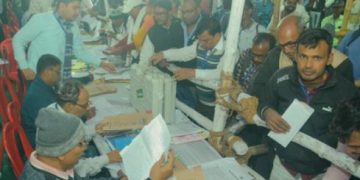By Shivaji Sarkar
The NDA’s stunning 202-seat sweep in Bihar—far above exit-poll expectations—has buoyed a shaken stock market but also revived debate on the sustainability of Bihar’s economy and what this political consolidation means for the state’s future. Election rhetoric centred on poverty, yet the deeper structural issues of Bihar’s stagnant economy remained largely unaddressed.
The vote-seat mismatch itself is striking. Despite RJD securing the highest vote share (22.1 percent)—1.13 crore votes—it won only 27 seats. By contrast, the BJP (20.7 percent – 99 lakh votes) won 89 seats and the JD(U) (18.9 percent – 95 lakh votes) secured 85, Congress got 43 lakh (6 seats), LJP-RV 25 lakh (19 seats). The crushing numbers have parallel in the last Maharashtra Assembly polls. BJP contested 189 seats. It won 132.
The spin has baffled observers and rattled an opposition that now raises questions about the Election Commission’s conduct. The unusual outcome has sparked worries about what such electoral patterns may mean for future contests, particularly for regional or smaller parties across India.
Law and order concerns persist in Bihar, highlighted by the Mokama killing and the electoral victory of Anant Singh, the accused. Meanwhile, 20 years of “Sushasan” have not translated into visible economic transformation. Nitish Kumar’s pre-poll cash transfers—including the Rs 10,000 scheme for women—may have helped electorally, but they cannot compensate for the structural weaknesses of the state. The contrary were RJD-Cong Mahagathbandhan (MGB) counter programmes for women. The MGB says as many women are for Nitish, as many are opposing him. Indian future political scenario could be more volatile.
Financial strategists view the decisive NDA victory as a market-positive outcome. Bihar’s microeconomy, however, has not enthused the businesses over the decades. The main reason behind Bihar’s poor state is both historical—it was always behind—and the lack of progress on investments. This does not mean that Bihar is not making any progress at all. In recent years, its gross state domestic product (GSDP) growth has consistently surpassed all-India growth. However, given Bihar’s low base, it would take years before the fast pace of growth changes.
Capital expenditure remains only 14 percent of the state’s total spending for 2025–26, far lower than peer states with similar income levels such as West Bengal, Uttar Pradesh, Madhya Pradesh and Jharkhand.
Bihar’s GSDP remains the lowest among major states. Its divergence from industrialised states has widened over time. In 2011–12, Bihar’s GDP was 34 percent of Tamil Nadu’s, 43 percent of Gujarat’s, and 41 percent of Karnataka’s. By 2021–22, these ratios had fallen to 32 percent, 35 percent, and 33 percent respectively.
Bihar’s per capita NSDP remains the lowest in India. In 1960–61, it was 70 percent of the national average; by 2005–06 it had fallen to 33 percent, and it remains near that today. The agricultural workforce has surged, not shrunk, as elsewhere in India. Between 2017–18 and 2022–23, the number of people working in agriculture jumped from 12.5 million to 19 million, a 50 percent increase. This reversal is due to returning migrants during the pandemic, shutters on local industries, and declining informal-sector jobs.
Manufacturing in Bihar has contracted, registering –1.1% growth over five years. The state hosts only 1.32 percent of India’s industrial units and contributes a negligible 0.5 percent to national factory value added. Its industrial base remains anaemic.
The state ranks 26th out of 29 in the Ease of Doing Business index. Unsurprisingly, it attracts just 0.29 percent of India’s FDI. Bihar’s share in India’s total exports is only 0.52 percent, and it ranks ninth among ten landlocked states in export preparedness.
Bihar ranks last or near last on most human development indicators. It sits at the bottom of NITI Aayog’s 2024 SDG Index. The state has the highest share of underweight and wasted children, among the highest infant and neonatal mortality rates, and the poorest sanitation access in India. Bihar faces crippling shortages of doctors, paramedics, nurses, teachers, and university staff. Around 60,000 health-sector posts remain vacant. The Good Governance Index ranks Bihar 15th of 18 major states—compounding its economic woes.
Despite its grim overall profile, Bihar has scored well on clean water and sanitation (SDG-6), ranking third nationally. Initiatives like the Bihar Next-Gen Lab show a shift toward data-driven governance, though their impact will take time to materialise.
To his credit, Nitish Kumar restored law and order after the RJD’s “jungle raj.” But overall this has not made an improvement.
On development, jobs, investment, and poverty alleviation, however, his record is dismal. With his political dominance now secure—and the opposition decimated—Nitish faces the same responsibility he failed to fulfil in 20 years: lifting Bihar out of chronic backwardness.
His thank-you to the voters contained no concrete roadmap. Whether Bihar will finally chart a new path remains an open question—and the nation is watching.
INFA






































